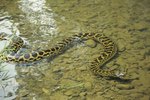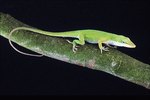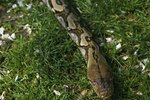
The non-venomous ball python is the smallest of all African python species. In the wild, these snakes are found throughout western and central Africa, including Ghana, the Ivory Coast and Togo. They rarely grow longer than 5 feet, with the average adult being between 3 and 4 feet long. Their size and calm temperament make them popular pet snakes. With proper care, they can live 20 to 30 years in captivity.
Housing
Because ball pythons are primarily terrestrial snakes, they appreciate more floor space in their cages than other snakes of their size. A 30-gallon aquarium is suitable for a single adult, provided it is clean, well-ventilated and free of any sharp points or edges that could scratch the snake. The python also requires some sort of temporary enclosure so its habitat can be cleaned and sanitized once a week. Chicago Exotics Animal Hospital recommends a dilute bleach-water solution, left on the cage’s surfaces for at least 10 minutes and then thoroughly rinsed.
Environment
In the wild, ball pythons spend much of their time hiding or resting in underground burrows. A captive ball python needs at least one, preferably two concealed retreats within its cage. The floor of the cage can be lined with newspaper or reptile carpeting. Snake owners typically use wood shavings more for aesthetic appeal. Cedar and pine should be avoided because they can cause respiratory problems. Aspen shavings can be used, but they sometimes cling to prey and can injure the snake if it swallows them. Whatever bedding is used, Chicago Exotics Animal Hospital recommends changing it weekly, at the same time the cage is cleaned and disinfected. Low branches, dry leaves or hay and rocks can also be added so the ball python has a variety of smells and textures to explore.
Temperature and Humidity
As native African snakes, captive ball pythons have specific temperature and humidity requirements to ensure the animal is healthy and comfortable. Because snakes are cold-blooded, a ball python’s enclosure should include both a warm side and a cool side so it can regulate its body temperature. The cage temperature should be between 80 and 85 degrees Fahrenheit on the cool side, between 90 and 95 degrees on the warmer end. Heating pads under the tank are the preferred method of maintaining these levels, which can be monitored using a reptile thermometer. Generally, the snake’s aquarium should have 50 to 60 percent humidity, although Chicago Exotics Animal Hospital recommends increasing the humidity to around 70 percent when the snake is shedding.
Feeding
Captive ball pythons eat mice or rats, which can be purchased at any pet store. Adults usually eat one mouse or rat per week, although they sometimes go as long as two weeks or a month without needing to feed. A good-sized prey rodent is no larger than the widest part of the snake’s body. Wild ball pythons are nocturnal, so captive animals may prefer night-time feedings, particularly if they were wild-caught. Chicago Exotics Animal Hospital recommends having a separate feeding cage so the snake will associate that cage with feeding, rather than its owner’s hand. As with any other animal, ball pythons require clean, fresh water that is changed at least daily.
References
Photo Credits
-
BananaStock/BananaStock/Getty Images
Writer Bio
Jennifer Mueller began writing and editing professionally in 1995, when she became sports editor of her university's newspaper while also writing a bi-monthly general interest column for an independent tourist publication. Mueller holds a Bachelor of Arts in political science from the University of North Carolina at Asheville and a Juris Doctor from Indiana University Maurer School of Law.




